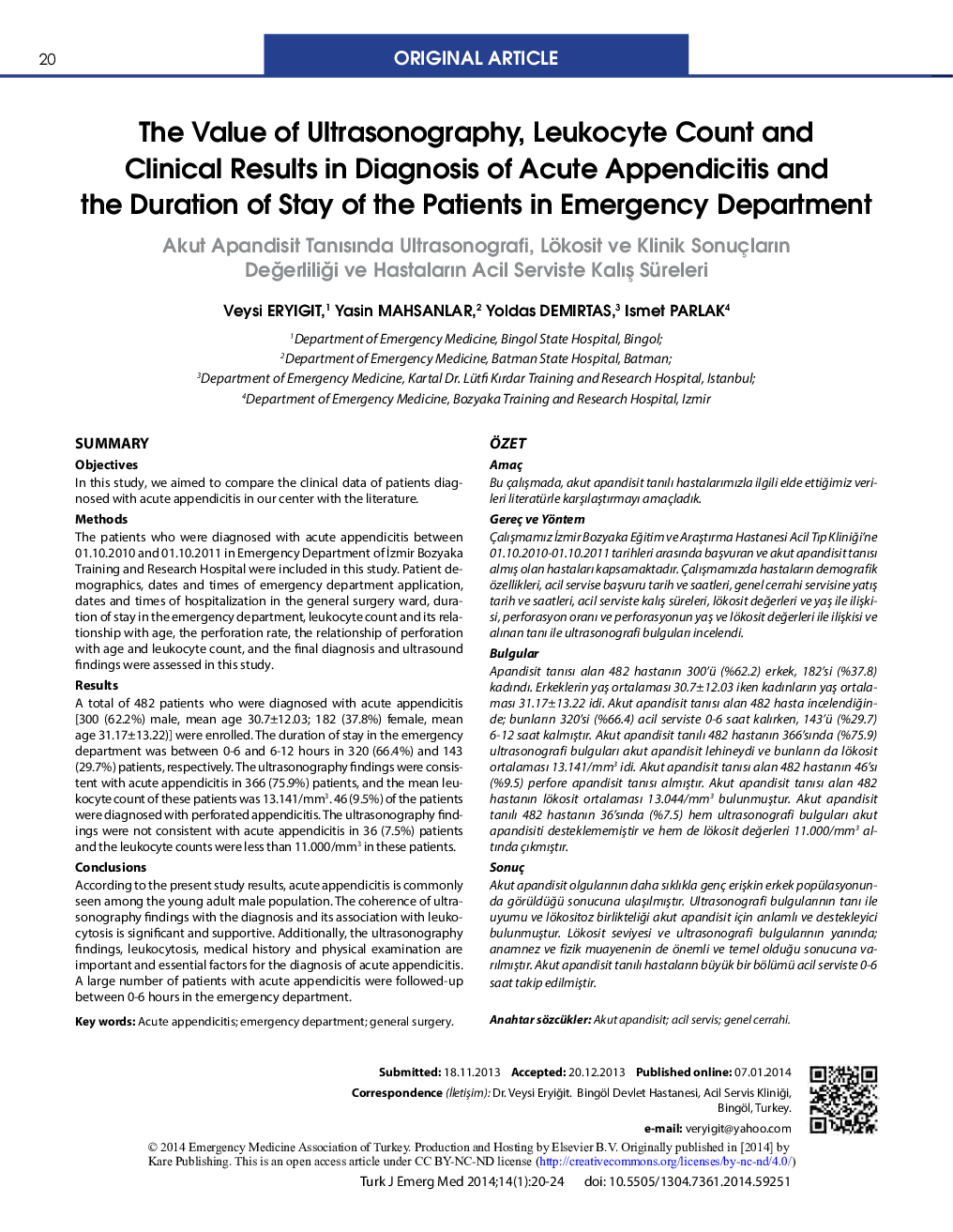| Article ID | Journal | Published Year | Pages | File Type |
|---|---|---|---|---|
| 2604186 | Turkish Journal of Emergency Medicine | 2014 | 5 Pages |
SUMMARYObjectivesIn this study, we aimed to compare the clinical data of patients diagnosed with acute appendicitis in our center with the literature.MethodsThe patients who were diagnosed with acute appendicitis between 01.10.2010 and 01.10.2011 in Emergency Department of İzmir Bozyaka Training and Research Hospital were included in this study. Patient demographics, dates and times of emergency department application, dates and times of hospitalization in the general surgery ward, duration of stay in the emergency department, leukocyte count and its relationship with age, the perforation rate, the relationship of perforation with age and leukocyte count, and the final diagnosis and ultrasound findings were assessed in this study.ResultsA total of 482 patients who were diagnosed with acute appendicitis [300 (62.2%) male, mean age 30.7±12.03; 182 (37.8%) female, mean age 31.17±13.22)] were enrolled. The duration of stay in the emergency department was between 0–6 and 6–12 hours in 320 (66.4%) and 143 (29.7%) patients, respectively. The ultrasonography findings were consistent with acute appendicitis in 366 (75.9%) patients, and the mean leukocyte count of these patients was 13.141/mm3. 46 (9.5%) of the patients were diagnosed with perforated appendicitis. The ultrasonography findings were not consistent with acute appendicitis in 36 (7.5%) patients and the leukocyte counts were less than 11.000/mm3 in these patients.ConclusionsAccording to the present study results, acute appendicitis is commonly seen among the young adult male population. The coherence of ultrasonography findings with the diagnosis and its association with leukocytosis is significant and supportive. Additionally, the ultrasonography findings, leukocytosis, medical history and physical examination are important and essential factors for the diagnosis of acute appendicitis. A large number of patients with acute appendicitis were followed-up between 0–6 hours in the emergency department.
ÖZETAmaçBu çalışmada, akut apandisit tanılı hastalarımızla ilgili elde ettiğimiz verileri literatürle karşılaştırmayı amaçladık.Gereç ve YöntemÇalışmamız İzmir Bozyaka Eğitim ve Araştırma Hastanesi Acil Tıp Kliniği'ne 01.10.2010–01.10.2011 tarihleri arasında başvuran ve akut apandisit tanısı almış olan hastaları kapsamaktadır. Çalışmamızda hastaların demografik özellikleri, acil servise başvuru tarih ve saatleri, genel cerrahi servisine yatış tarih ve saatleri, acil serviste kalış süreleri, lökosit değerleri ve yaş ile ilişkisi, perforasyon oranı ve perforasyonun yaş ve lökosit değerleri ile ilişkisi ve alınan tanı ile ultrasonografi bulguları incelendi.BulgularApandisit tanısı alan 482 hastanın 300'ü (%62.2) erkek, 182'si (%37.8) kadındı. Erkeklerin yaş ortalaması 30.7±12.03 iken kadınların yaş ortalaması 31.17±13.22 idi. Akut apandisit tanısı alan 482 hasta incelendiğinde; bunların 320'si (%66.4) acil serviste 0–6 saat kalırken, 143'ü (%29.7) 6–12 saat kalmıştır. Akut apandisit tanılı 482 hastanın 366'sında (%75.9) ultrasonografi bulguları akut apandisit lehineydi ve bunların da lökosit ortalaması 13.141/mm3 idi. Akut apandisit tanısı alan 482 hastanın 46'sı (%9.5) perfore apandisit tanısı almıştır. Akut apandisit tanısı alan 482 hastanın lökosit ortalaması 13.044/mm3 bulunmuştur. Akut apandisit tanılı 482 hastanın 36'sında (%7.5) hem ultrasonografi bulguları akut apandisiti desteklememiştir ve hem de lökosit değerleri 11.000/mm3 altında çıkmıştır.SonuçAkut apandisit olgularının daha sıklıkla genç erişkin erkek popülasyonunda görüldüğü sonucuna ulaşılmıştır. Ultrasonografi bulgularının tanı ile uyumu ve lökositoz birlikteliği akut apandisit için anlamlı ve destekleyici bulunmuştur. Lökosit seviyesi ve ultrasonografi bulgularının yanında; anamnez ve fizik muayenenin de önemli ve temel olduğu sonucuna varılmıştır. Akut apandisit tanılı hastaların büyük bir bölümü acil serviste 0–6 saat takip edilmiştir.
